The Water Moccasin
Agkistrodon piscivorus
In previous episodes of "Nature Nook" we've highlighted various birds, plants and mammals. Nice, harmless, lovable things. I thought it was time to cover something in another category, something not so easy to love, something that will freak-out many people: SNAKES!
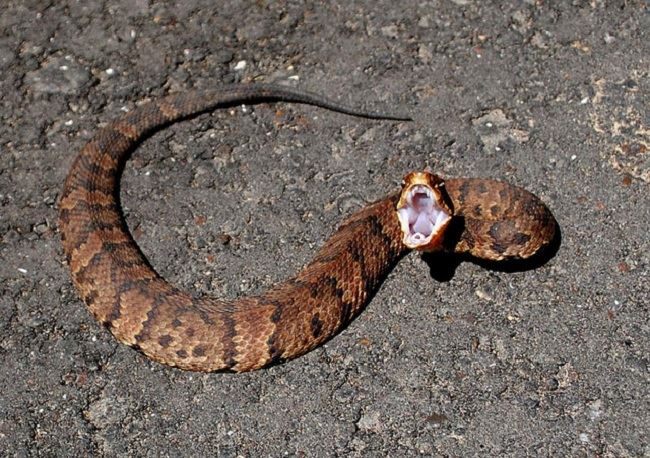
And of course, it has to be related to canoeing, so I'll cover here the water moccasin, a type of snake that we often encounter on our waterborne adventures in the Houston area. There is a plethora of information available on moccasins, too much to put it all here, so I'll try and distill it down to the essentials that we should know about to survive moccasin encounters and satisfy our basic curiosity about them.
The scientific name of the moccasin is agkistrodon piscivorus. "Agkistrdon" is Greek for "hooked tooth", and "piscivorus" is Greek for "fish eater". Thus, the name translates into “hooked-tooth fish-eater”, which is a good description. Beyond the scientific name, more common names include water moccasin, swamp moccasin, black moccasin, and cottonmouth. "Cottonmouth" refers to the threat display, where the snake will stand its ground facing the intruder with its mouth open, exposing the white lining of its mouth.
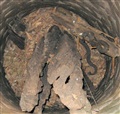 |
|
 |
|
 |
I found these two moccasins
trapped
at the bottom of an old brick
well in
the Addicks Reservior. |
|
This moc was swimming in
Oyster Creek by the
Sugarland Airport |
|
Notice how high the body
floats on the surface of the
water |
The moccasin is the world's only semi-aquatic venomous snake, usually found in or near water, particularly in slow-moving and shallow lakes, streams, and marshes. The snake is a strong swimmer and will even enter the sea. It has successfully colonized islands off both the Atlantic and Gulf coasts. The snake is not limited to aquatic habitats, however, and can even be found more than a mile from water. In some locations, the species is well-adapted to less moist environments.
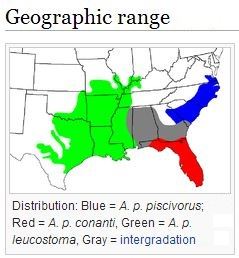 The moccasin is found in the southeastern United States. Adults are large and can deliver a painful and potentially fatal bite. When antagonized, they will stand their ground by coiling their bodies and displaying their fangs. The threat display may include vibrating its tail, which, if vibrating against dry leaves, can sound like a rattlesnake. Their aggression is often over-exaggerated, and in my personal experience with a half dozen or so encounters with moccasins, they just get defensive and want to be left alone. One should honor that. But on rare occasions, territorial males may approach intruders. You're likely to get bitten by them only if you try and pick them up or step on them. So don't do that! And let me answer this question once and for all: they ARE capable of biting while underwater!
The moccasin is found in the southeastern United States. Adults are large and can deliver a painful and potentially fatal bite. When antagonized, they will stand their ground by coiling their bodies and displaying their fangs. The threat display may include vibrating its tail, which, if vibrating against dry leaves, can sound like a rattlesnake. Their aggression is often over-exaggerated, and in my personal experience with a half dozen or so encounters with moccasins, they just get defensive and want to be left alone. One should honor that. But on rare occasions, territorial males may approach intruders. You're likely to get bitten by them only if you try and pick them up or step on them. So don't do that! And let me answer this question once and for all: they ARE capable of biting while underwater!
Moccasin venom is more toxic than a copperhead, and can cause tissue destruction. The effects are local around the bite location, and do not effect the entire body or the nervous system like rattlesnake venom. Symptoms include skin discoloration caused by the escape of blood into the tissues from ruptured blood vessels, and swelling. If untreated, tissue may die due to lack of blood flow. There may be involuntary muscle contractions. The pain is worse than a copperhead, but less than a rattlesnake. (I want to know who experienced all three in order to make this comparison!) Bites can be effectively treated with antivenom serum.
 |
|
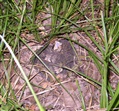 |
|
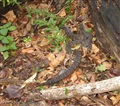 |
A beauty in the Addicks
Reservoir near
South
Mayde Creek |
|
Coiled and agape:
"Stay away!"
South Mayde Creek |
|
Two for one by a log.
South Mayde Creek |
The moccasin diet consists mainly of fish and frogs but is otherwise highly varied. It may also dine on mammals, birds, amphibians, insects, mice, bats, other snakes, small turtles, and even baby alligators! So that's what they eat, but what about who eats them? Moccasins are prey for snapping turtles, alligators, large birds like owls, hawks, herons and egrets, and other snakes,
Though the majority of specimens are almost or even totally black, the color pattern may consist of a brown, gray, tan, yellowish-olive or blackish ground color, which is overlaid with a series of dark brown to black bands. These bands are sometimes broken along the back to form a series of staggered half-bands on either side. There are spots between the bands of the young, and these are often retained even in adults. The banding pattern and spots fade with age, so older individuals are an almost uniform olive-brown, grayish-brown or black. The belly is white, yellowish-white or tan, marked with dark spots. The broad head is distinct from the narrow neck, with a blunt snout.
 |
|
 |
|
Hidden in the grass
and hard to see.
South Mayde Creek
|
|
Backed into a corner
against a tree trunk.
South Mayde Creek |
There are many water snakes which are often mistaken for moccasins, and they can be distinguished by narrow rounded heads the same diameter as the body without a distinct neck. Venomous snakes will have elliptical pupils like a cat's eye, while non-venomous snakes have round pupils. You may not want to get close enough to notice this - if you're close enough to see the pupils of their eyes, you may be within striking distance! And notice in the photo on the right and below, that the pupil can be hard to see because there is a horizontal black band that run across the eye too. A moccasin will swim with it's entire body on the surface of the water, while a water snake will swim with only it's head above water.
Moccasins may be active during both day and night. On hot days they are usually found coiled or stretched out in shade. In the morning and on cool days, they can often be seen basking in the sunlight. They often emerge at sunset to warm themselves on warm ground and then become very active throughout the night.
Females may reproduce starting at about three years of age. They hold their eggs inside their body, and then give live birth to the hatchlings in litters of 6 to 8, but sometimes as many as 20.
 |
|
 |
|
Holding a moc down with my
walking stick to get a photo.
South Mayde Creek
|
|
Close-up of head
with cats-eye pupil. |
There you have it! Don't panic if you see a moccasin - just keep yourself at a safe distance and enjoy the view of one of nature's amazing creatures. If you do happen to be bitten, get to a hospital as soon as possible, and realize that it's very unlikely that the bite will be fatal.